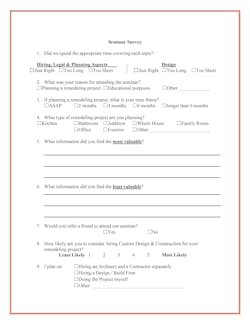A couple of years ago during a growth spurt, the managers of Custom Design & Construction realized that the company’s design department was stretched too thin. The clue: Otherwise-happy clients mentioned it on customer satisfaction surveys once their jobs were completed.
“Our designer was working hard and charging through it, and we didn’t notice that there wasn’t enough time for each client,” says Barbara Gallella, director of marketing for the Los Angeles-area design/build firm. “It was easy to just be focused on the growth.”
Other than the survey results, there was no indication of any issues. “Two or three clients said they were happy with their jobs but wished they had more time with the designer,” Gallella says. “When [clients] love you, they don’t want to complain; they don’t want you to think they don’t like you,” she adds. On a survey, however, a homeowner is more likely to offer honest feedback.
Based on that feedback, Custom Design & Construction later hired two more designers.
Approximately half of remodelers conduct some sort of post-job customer-satisfaction survey, estimates Joaquin Erazo, president of Leesburg, Va.-based Marketing Wing, whose consulting firm specializes in design/build. It’s a necessary part of doing business at a time when unhappy customers are comfortable taking to the internet with their complaints. “Surveys are a way to head off any negative feedback in a public platform,” Erazo says. “[Clients] feel they have been heard.”
Here are nine tips from remodelers and consultants who use customer satisfaction surveys to boost business.
1. Introduce the survey
There is much discussion in the remodeling field about how to position surveys for the highest response rate. Many remodelers ask the project manager or designer to personally reach out to the homeowner and ask him or her to fill out the questionnaire since they often have the closest relationship. Others take the opposite approach and assign the task to someone not directly involved with the project at all—a marketing professional, for example—since a client may feel more comfortable giving negative feedback to someone they don’t know.
Whatever approach you take, it’s important to let homeowners know that the survey is on its way and to ask them to fill it out. Remodelers should also follow up with a personal phone call thanking each client for filling out the survey.
2. Consider length
The number of questions on the survey isn’t as important as the time it will take someone to fill it out. Even customers who have completed large-scale remodels will lose patience with surveys containing more than 15 questions, says Laura Summerlin, director of member success at GuildQuality, which specializes in customer satisfaction surveys.
3. Know when to use open-ended questions vs. multiple choice
Remodelers who are “honestly looking for feedback and genuinely want to walk away with something they can improve” should send surveys with open-ended questions rather than asking for a 1-to-10 rating, Erazo says.
His favorite questions: Which three things almost stopped you from using us? What would you miss most about us if you couldn’t hire us again? If you had to pick one thing that we could improve, what would that be? Is there any one person on our team whom you would like to recognize, good or bad?
This survey, from Custom Design & Construction, in the Los Angeles area, uses a mix of several question types including multiple choice and open-ended, as well as a rating-scale question.
4. Get a Net Promoter Score
Back in 2003 business expert Fred Reichheld introduced a concept called the Net Promoter Score (NPS). The premise is that a business really needs to know only one thing from its customers: what they will tell their friends about the company. Studies have shown that companies that receive a high NPS tend to be the most profitable.
To get the score, use a 10-point scale to ask the question: How likely are you to recommend [company] to a friend or colleague?
Anyone who answers with a 9 or 10 is a “promoter.” These customers are highly likely to hire you again, refer your company to their friends, and/or write positive reviews online. They add equity to a brand and help create growth for the businesses they support.
Anyone who responds with a 7 or 8 is a “passive” and is neither good nor bad for a company’s reputation.
Finally, there are “detractors,” people who answer the question with
a 6 or below.
To learn your NPS, subtract the percentage of detractors from the percentage of promoters. Passives count toward the total number of respondents, but don’t affect the score.
The possible range for an NPS goes from -100 (everyone is a detractor)
to +100 (everyone is a promoter).
5. Take immediate action on negative responses
Most remodelers and third-party surveyors code each survey so they know which client filled it out. That way they can respond to complaints by quickly addressing the problem.
6. Don’t limit surveys to clients
Gallella surveys nearly everyone who makes contact with Custom Design & Construction, even if the potential customer doesn’t hire her company.
Homeowners who attend the remodeler’s seminars or meet with a designer but do not hire the firm get a five-question survey asking for feedback on the speakers and whether they intend to hire another company. “That’s a more interesting group to survey,” Gallella says. “We get to see what their impression is of our design team and our business; to get an idea of whether they understand the difference between design/build and an architect or just someone working out of their truck.”
7. Let your staff know about the surveys
Shreveport, La., remodeler Jeb Breithaupt, president of JEB Design/Build, tells a story about a friend who had a bad experience with a rude, careless cable TV technician when he moved to a new home. A couple of years later, the friend moved again, and the cable company sent the same tech, who couldn’t have been more professional or helpful.
The difference, the tech explained to the homeowner, was that his company had started sending customer satisfaction surveys to clients, and he knew the client might report the experience. When those reports are positive, Summerlin notes, remodelers should share that, too. “It’s good for morale,” she says.
8. Consider using a third-party survey company
Customers are more likely to offer honest criticism to someone they don’t know, says Summerlin, whose service starts at $100 monthly for three surveys per month. “Put yourself in the homeowner’s position,” she suggests.” “It’s really hard to personally deliver criticism.”
Plus, she says, some customers will keep small complaints to themselves because they fear the remodeler will consider them petty if they bring them up in person. And, Summerlin notes, “It’s hard to grow and improve on customer satisfaction if you don’t know the problem the customer is facing.”
Erazo agrees, noting that homeowners sometimes
fear that any negative feedback will cause trouble for the crew members who worked in their homes.
He suggests another reason to enlist an outside survey firm: “Today’s consumer doesn’t necessarily believe what companies are saying about themselves, but they do believe what others are saying.”
9. Use what you learn
Analyze the results and be diligent about it. By comparing survey results over time, company owners can learn important trends about performance—both good and bad.
About the Author
Sharon O'Malley
Sharon O’Malley has covered the home building and remodeling industries for 20 years. She is based in College Park, Md., where she is a member of the adjunct faculty at the University of Maryland’s Philip Merrill College of Journalism.

